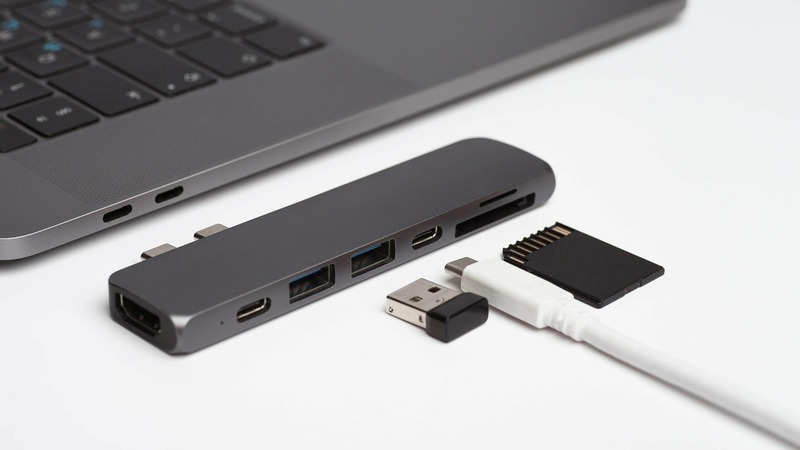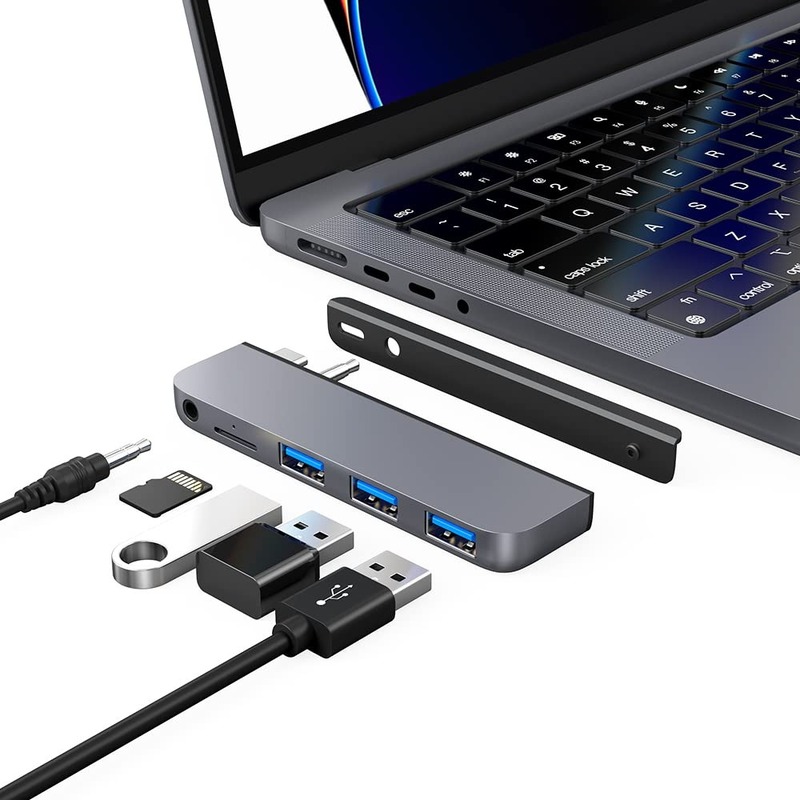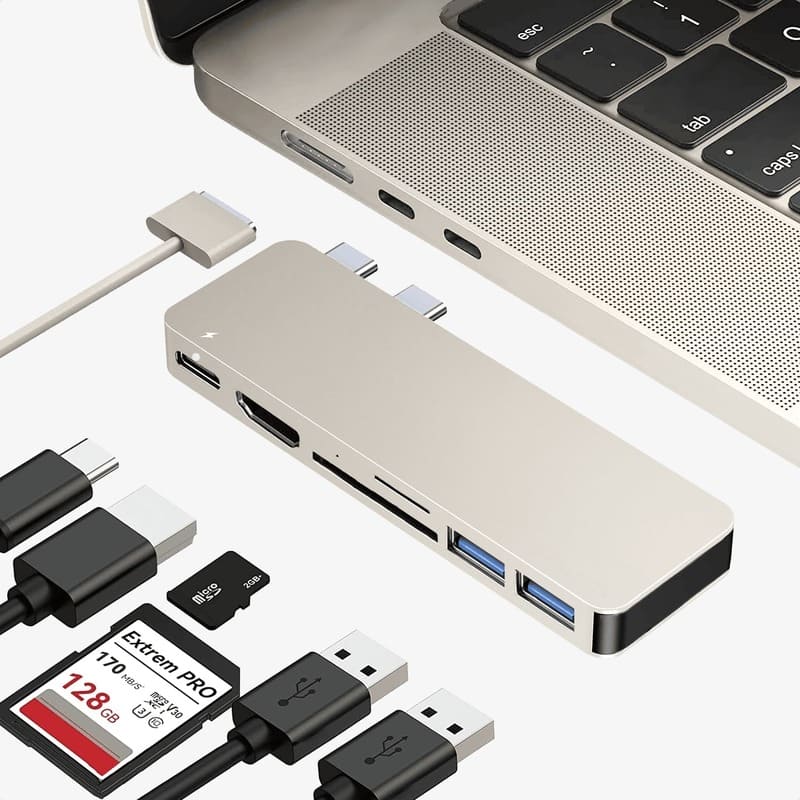USB Hubs
Does a USB Hub slow down devices? How to improve speed
When using a USB hub, many people wonder if it can slow down the speed of their devices. Connecting too many devices to one hub can affect performance, but if you choose the right product, you can avoid this issue. Let’s take a detailed look at how to select a USB hub and use it effectively to prevent device speed from slowing down in the article below!
What is a USB Hub used for?
A USB hub is a device that expands the number of USB ports on a computer or laptop, allowing you to connect multiple peripherals to a single USB port. Typically, each computer or laptop only has a limited number of USB ports, but when you need to connect multiple devices like a mouse, keyboard, printer, speakers, external hard drive, or memory card simultaneously, a USB hub will be an effective solution.
Detailed Benefits of a USB Hub:
- Expand Connectivity: Adds multiple USB ports, allowing multiple devices to connect simultaneously without the need for frequent plugging and unplugging.
- Space-Saving: Helps avoid the need for multiple USB ports on your computer, especially useful when your computer has limited connection ports.
- Supports Power-Hungry Devices: A powered USB hub supplies enough power for devices that require more energy, such as external hard drives, scanners, or printers.
- Portable and Convenient: USB hubs are compact and easy to carry, ideal for use with laptops in various working environments.
In addition to the basic functions, USB hubs can also come with added features like supporting USB 3.0 or USB-C for faster data transfer.

Does a USB Hub slow down devices?
A USB hub can slow down the data transfer speed of devices if you connect too many devices to a single USB port. This happens because the bandwidth of the USB port is shared between the devices, leading to decreased performance. However, if you use a newer USB hub, such as USB 3.0 or USB-C, data transfer speeds will be less affected. Additionally, a powered hub will help maintain stable performance for energy-demanding devices. In conclusion, the impact on speed mainly depends on the number of devices and the type of hub used.
Factors that affect device speed when using a USB hub
When using a USB hub, the data transfer speed of devices can be affected by several factors. Below are the main factors that influence performance when using a USB hub.
USB Standard (USB 2.0, USB 3.0, USB-C)
The data transfer speed of a USB hub depends on the supported USB standard. USB 2.0 has a maximum speed of 480 Mbps, which is suitable for devices with lower bandwidth needs. USB 3.0 is faster, reaching 5 Gbps, which improves data transfer speed when connecting multiple devices. USB-C offers even faster speeds, up to 10 Gbps or more, making it ideal for modern devices. Choosing the right USB standard helps optimize performance when using a hub.
Number of Devices Connected
When you connect multiple devices to a USB hub, the bandwidth of the USB port is shared between the devices, leading to slower transfer speeds. This is especially noticeable if the devices require high bandwidth, such as external hard drives. If you connect too many devices, the overall speed will slow down. However, if only a few simple devices are connected, the speed is less likely to be affected. Managing the number of devices connected will help maintain stable speed.

Power supply
Some USB hubs do not have their own power source and rely on the computer for power, which can be limiting when connecting power-hungry devices. Without enough power, devices like external hard drives may experience performance issues or fail to function. Powered USB hubs provide sufficient power for larger devices, helping to maintain stable data transfer speeds. Choosing a powered hub is a solution for devices that consume more power.
Quality of the USB Hub
The quality of the USB hub significantly affects data transfer speed and performance. Low-quality hubs can cause bandwidth bottlenecks, reducing data transfer speeds. Inexpensive hubs often do not support high bandwidth and may struggle when connecting multiple devices. Hubs from reputable brands are better designed, optimized for data transfer, and ensure stable performance. Choosing a high-quality hub helps reduce slowdowns.
Cable and physical factors
The USB cable and its length can also affect data transfer speeds. Long or low-quality cables may cause signal degradation, leading to slower speeds. Cables that are not compatible with the hub’s standard can also reduce transfer efficiency. Using short, compatible, and high-quality cables with the hub ensures stable speed. High-quality cables ensure that the signal is not interrupted, optimizing data transfer rates.

How to use a USB Hub without affecting speed
To use a USB hub without slowing down speed, you need to implement a few optimization measures. Choosing the right type of hub, connecting devices properly, and ensuring a stable power supply will help improve performance. Below are some simple ways to use a USB hub effectively without affecting data transfer speeds.
Ways to Use a USB Hub Effectively:
- Choose a Hub with Fewer Ports if You Don’t Need Many Connections: If you don’t need to connect too many devices, choosing a hub with fewer ports will reduce the bandwidth load and maintain stable speed.
- Ensure Your System Supports Sufficient Transfer Speeds: Check that your devices support fast USB standards like USB 3.0 or USB-C to fully utilize the hub’s data transfer speed.
- Avoid Using the Hub When Transferring Large Data: If you are transferring large data or using applications that require high bandwidth, avoid connecting the hub during this time to prevent performance degradation.
- Update Drivers for the Hub and Connected Devices: Ensure that the drivers for your USB hub and peripherals are always up-to-date to maintain compatibility and transfer speed.
- Properly Position the Hub: Avoid connecting the USB hub to faulty or overloaded ports to ensure that data transfer performance is not affected.
Additionally, selecting the right USB hub is crucial to ensure optimal performance for connected devices. A high-quality USB hub not only maintains transfer speeds but also protects your devices from issues like power overloads or disconnections. For example, USB hubs from reputable brands like Eili feature a refined design, strong bandwidth handling capabilities, and stable power supply support, enhancing your user experience and ensuring work efficiency.

In conclusion, the question “Does a USB hub slow down devices?” depends on various factors such as the type of hub, the number of devices connected, and the quality of the devices. If you choose the right USB hub and use it properly, the issue of slowed speeds can be minimized. To ensure optimal performance and avoid slowing down your devices, check out quality USB hubs from Eili to find the right option that suits your needs.


